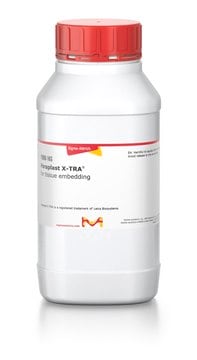P3683
Paraplast Plus®
for tissue embedding
Synonym(s):
Paraffin – polyisobutylene mixture
Sign Into View Organizational & Contract Pricing
All Photos(3)
About This Item
Recommended Products
form
solid
mp
56-57 °C (lit.)
56-57 °C
application(s)
hematology
histology
storage temp.
room temp
Related Categories
General description
Paraplast Plus® is a tissue embedding medium comprising highly purified paraffin and polyisobutylene with approximately 0.8% DMSO added to improve infiltration, sectioning, and penetration into tissues. It is recommended for tissues that are difficult to process with regular Paraplast®. Paraplast Plus® cuts continuous ribbons at 2μm thickness or short ribbons at 1μm thickness.
Application
- Paraplast Plus® has been used in the examination of vertebral specimens of Malacoraja senta.
- It has also been used in the identification and expression analysis of PIN genes in rice.
- It has been used in the study of glucose transport mechanisms in uterine tissues during pregnancy.
- It has been used to embed Bouin′s fixed carp tissues, rat ventral prostatic fragments, and common bean (Phaseolus vulgaris L.) nodules.
Legal Information
Paraplast is a registered trademark of Leica Biosystems
Paraplast Plus is a registered trademark of Leica Biosystems
Storage Class Code
11 - Combustible Solids
WGK
WGK 2
Flash Point(F)
Not applicable
Flash Point(C)
Not applicable
Personal Protective Equipment
dust mask type N95 (US), Eyeshields, Gloves
Certificates of Analysis (COA)
Search for Certificates of Analysis (COA) by entering the products Lot/Batch Number. Lot and Batch Numbers can be found on a product’s label following the words ‘Lot’ or ‘Batch’.
Already Own This Product?
Find documentation for the products that you have recently purchased in the Document Library.
Micro-morphology of common bean (Phaseolus vulgaris L.)
nodules undergoing senescence
nodules undergoing senescence
Fabia'n Ferna'ndez-Luquen?o ? L.
Acta Physiologiae Plantarum / Polish Academy of Sciences, Committee of Plant Physiology Genetics and Breeding (2008)
Nozomu Yoshioka et al.
Disease models & mechanisms, 13(5) (2020-06-03)
Loss-of-function mutations in dystonin (DST) can cause hereditary sensory and autonomic neuropathy type 6 (HSAN-VI) or epidermolysis bullosa simplex (EBS). Recently, DST-related diseases were recognized to be more complex than previously thought because a patient exhibited both neurological and skin
Identification and expression analysis of PIN genes in rice
Miyashita, et al.
Plant Science, 178(5) (2010)
Ellen C R Leonel et al.
Theriogenology, 105, 97-106 (2017-09-25)
Ovarian tissue transplantation could be a valuable technique for the preservation of endangered animals. The domestic cat affords an adequate experimental model for studies aimed at wild felids due to its phylogenetic similarity. Thus, this pilot study evaluated the efficacy
Shuaibin Zhang et al.
Scientific reports, 6, 23173-23173 (2016-03-19)
Early fruit development is crucial for crop production in tomato. After fertilization, the ovary undergoes cell division and cell expansion before maturation. Although the roles of regulatory signals such as hormone and carbohydrate during early fruit development have been studied
Related Content
Three-dimensional (3D) printing of biological tissue is rapidly becoming an integral part of tissue engineering.
Our team of scientists has experience in all areas of research including Life Science, Material Science, Chemical Synthesis, Chromatography, Analytical and many others.
Contact Technical Service








